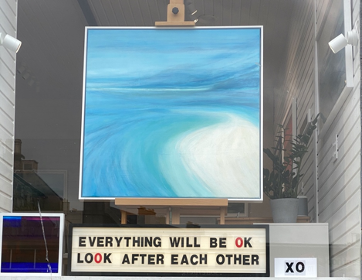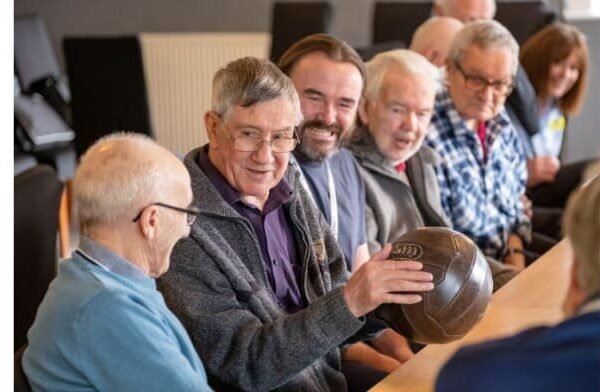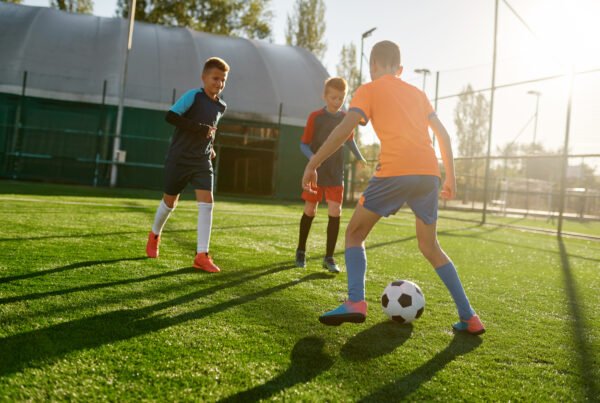‘Everything will be OK (if we) look after each other’
By CHARLIE RAEBURN
This sign in the window of an art gallery in Edinburgh stopped me momentarily in a quiet walk around town during the COVID crisis. The first thought was ‘Will it? Will we?’; and since then my mind has been consumed with how we draw on this period of reflection to ensure that we might, actually and sincerely, ‘look after each other’.
The first task was to write down my thoughts, share them, and seek a wider understanding of how this can be done cohesively, locally and nationally, and in a way that has the necessary impact. In truth, that fuelled the setting up the Observatory for Sport in Scotland, and virtually every day since we officially launched as a charity in 2016 has been spent engaging more and more people, listening to them and their issues, and striving to plot a path through the systems and structures of government and national bodies, to link those myriad interests to the community roots of our society.
So, this is the first in a series of articles written to widen the discussion and debate. We have an opportunity to drive change, or as the New Zealanders are terming it, to be “different and better”, in how we model the future for Scottish people in a way that breaks free of red tape, disappointment and pessimism, and brings stakeholders (hate the word, but it seems to be the most understood these days) on to the same page in breathing new life into civic society.
We would be delighted if you would take a few minutes to read these thoughts and come back to us with your views. Everyone who lives in Scotland is part of our society, and all will have a take on what’s important to our quality of life, what they would like to see in their communities and how we work together to make it happen, so we welcome thoughts from every single reader. We are especially keen to hear from the wider Scottish civic society.
The final article in the series of four will feature an OSS manifesto, drawing on the feedback and our discussions with key national and community people.
‘Everything will be OK if we look after each other.’ Let’s do that and see how far we get.
Charlie Raeburn (Founder & Chairman, OSS)
Reflections on Scottish Sport as part of a vision of a Participating Scotland
I write this recognising that the current pandemic crisis is very significant for Scotland. So thinking and talking about the future may appear fanciful. But I live in hope!
It has also given us something valuable: time to reflect. Time to pause, spend time with family and friends and reconsider what is most important to us. And realise the value of social interaction, fun and joie de vivre.
In December, many will inevitably be reflecting on the decade 2011-2020. In my case, I will be thinking particularly about what has happened to community sport, and considering the next decade, 2021-30, and how we rebuild, refresh and renew ‘Sport for People’ in Scotland. I advocate that this reflection be considered with all the various components of civic society from music and culture, through faith groups to uniformed organisations such as Scouts, Guides, Boys Brigade and others.
Looking back
As I write, Scottish sport, leisure and culture trusts are warning of the closure of over 100 community facilities as a result of significant budget challenges.
Much of the last decade’s economic activity and participation levels have been shaped by austerity. With the notable exception of some outdoor activities, such as recreational walking and cycling, and the rise in gym memberships – which underlines how people still value personal health and fitness – most “traditional sports” have experienced a considerable reduction in participation. Many rugby, football, cricket and hockey clubs that 30 years ago fielded four or five adult teams, and a series of youth sides, every weekend, are now reduced to one or two and scrabbling for people to make up teams. Swimming, squash, tennis, golf and others share similar stories of club memberships sliding over the past decade or two.
There are more opportunities in our world now, and more entertainment, but often at a price. Sports have found it difficult to embrace more casual forms of participation, tighter demands on time and money, and many remain exclusive rather than inclusive.
Putting aside the challenges that presents for individual sports, what has that done to our people, our communities and society, where those regular social opportunities and escapes from stress, now including technology? Where are the opportunities for belonging in civic Scotland?
For many breaks from activity didn’t come through a positive choice. It came from a combination of loss of opportunity, dwindling choice and increasing barriers to access, and sport failing to adapt to modern needs. That, and its impact on society, has come home to me during lockdown.
Do we recognise the need for a civic society and, if we do, do we embrace it, in the sense of investing in it, grasping its strengths to help people, and, now, help Scotland recover mentally and physically from an unprecedented period of isolation? Are we thinking along those lines, or are we going to slide back into the maelstrom of the society we had become, looking out for no1 and leaving our and our community’s health as something to think about ‘later’?
I write this recognising that the current pandemic crisis is still very significant, and has had tragic consequences for far too many. Thinking and talking about the future may appear fanciful, but I do it in the sincere belief that we need both reflection and forward-thinking at this time.
Local authorities who traditionally assumed a development and facilitation role have experienced more than a decade of cuts to annual budgets. Most Scottish councils handed management of sport, leisure and recreation, along with culture, to charitable trusts in an effort to save costs and protect facilities and jobs. But still the cuts went on and so those trusts have been forced to become commercial entities, tasked with sustaining sport, leisure and recreation almost wholly on the income they generate. So costs go up, opening hours reduce, facilities close, more people who rely on local facilities are excluded and participation overall falls. It is a damaging cycle that has created a race to the bottom.
Who suffers? People of all ages. Communities. Our civic society. Local authorities have no statutory responsibility for sport; genuine monitoring, support, accountability to the public and ‘Key Performance Indicators’ appear a thing of the past. There has been great work done by a wealth of people to persuade the Scottish Government of the value of encouraging people to walk to tackle obesity and other wellbeing challenges. But that has been relatively easy and costs little.
But, hold on, where are those people walking to? Who is meeting them and helping them into a lifelong routine of exercise? What is it that keeps people returning to exercise? The safety of a new path, literally, an endorphine rush and the chat with friends are all factors, but of greater, long-lasting benefit to people is the experience of fun and exciting physical activity with other people, as part of a weekly routine; the kind that people invented to escape stress and called ‘sport’, and turned into a core part of life for people of all ages across the world.
It is that that many people have commented in the media in the past few months as being the big loss from their lives. We now have an opportunity to grow that again, using it to build our civic society, strengthen communities, reduce isolation and improve health and wellbeing. At OSS, we are building research and evidence, and momentum, to help our nation to grasp it.
Economic commentary
In OSS studies published in 2018-19, Dr Larissa Davies revealed that Scottish consumers spent around £2.5 billion on sport. This represents 2.8% of total expenditure in Scotland, and it is rising. Approximately 58% of all sport-related consumer spending was on sport participation, and clothing and footwear was the single largest participation-related category, accounting for 37% of all participation-related expenditure8.
Sport-related GVA was £2.5 billion in 2014, or 2.1% of overall GVA in Scotland. This indicator has grown continuously since 1998 (1.5%). Similarly, sport-related employment, which was 57,500 in 2014, has grown from 1.6% of all employment in Scotland in 1998 to 2.6%. It can be seen from the indicators presented that the economic importance of sport in Scotland has grown at a faster rate than the overall economy over the last 20 years.
Re-imagining our future
Hopefully, people will reflect on how much they have missed the social dimensions of sport during the Covid-19 crisis; the feeling of belonging to ‘extended families’, the fun and playfulness of sport, and the healthy lifestyles. The crisis has also demonstrated that we are not doing well in general with Health and Wellbeing.
But sport needs to embrace these challenges, including poverty, age demographics, the workplace, costs of participation, and local / accessible opportunities.
Bank of England also seeking social change
Andy Haldane, Chief Economist of the Bank of England wrote recently in the Financial Times
“…. one source of capital as in past pandemics is bucking these trends, social capital. This typically refers to the networks of relationships across communities that support and strengthen societies. From surveys we know that people greatly value these networks even though social capital itself is rarely assigned a monetary value.
“The need to change how societies and companies keep the score, to better recognise all the capital and all the paid and unpaid contributions citizens make is surely a lasting lesson from this crisis.
“Restoring social capital also means strengthening the infrastructure that underpins the social sector, embedding for good the new model army of volunteers the crisis has spawned. To that end, national civic service should be established as a goal for everyone, young and old, rich and poor, supported and recognised by government and businesses.”
Haldane reminds us that Lord Beveridge, who orchestrated much of the massive volunteer efforts of World War 2 through the welfare state and the NHS, recommended to the post-war Government in 1948 a fruitful cooperation between the public authorities and voluntary agencies, as it “was a special feature of British public life”. No institutional pillars were built for the social sector.
Haldane concludes:
“It is time to return to Beveridge’s words. We need to invest the rich and endowment of social capital created by the crisis, by rethinking and rebuilding the institutional immune system that is our social sector”.
Let me know what you think and join the discussion with comment at the bottom of this page.
Read the full series here:





Thought Piece from Charlie Raeburn for Reform Scotland